Helena P. Schrader's Blog, page 42
March 11, 2017
Writing Biographical Fiction: Aimery de Lusignan
 The "Grael" Tapestry by Edward Burne-JonesGuy de Lusignan is remembered as the king who lost the Kingdom of Jerusalem by his incompetent leadership in 1186-1187, and he has consequently received a lot of attention in histories and novels. Yet Guy was not the only Lusignan to make his fortune in the Holy Land. On the contrary, he was following in the footsteps of his older brother Aimery, and it was Aimery, not the feckless Guy, who founded a dynasty.
The "Grael" Tapestry by Edward Burne-JonesGuy de Lusignan is remembered as the king who lost the Kingdom of Jerusalem by his incompetent leadership in 1186-1187, and he has consequently received a lot of attention in histories and novels. Yet Guy was not the only Lusignan to make his fortune in the Holy Land. On the contrary, he was following in the footsteps of his older brother Aimery, and it was Aimery, not the feckless Guy, who founded a dynasty. Furthermore, for a series of novels about the Balian d’Ibelin, Aimery was in many ways more important than Guy because, long before his more famous younger brother landed in the Holy Land, Aimery had married an Ibelin ― Baldwin’s daughter/Balian’s niece Eschiva. Critically, while the bitter hostility of the Ibelin brothers to Guy de Lusignan is well documented, the facile assumption made by most historians that the Ibelins were automatically also hostile to Aimery is, I think, seriously flawed.
On the contrary there are clear indications (starting with the marriage of Eschiva) that the Ibelins were initially and again later on good terms with Aimery. After all, Aimery and Guy were two very different people, and opposition to an arrogant and incompetent usurper does not automatically entail or require opposition to a modest, wise and competent older brother ― no matter how loyal he was to his brother. Last but not least, within just a few short years of Guy's death, the Ibelins had become (and were proud to be) the staunchest defenders of Aimery’s dynasty. They held extensive fiefs in Aimery’s kingdoms, and Aimery appointed Balian’s eldest son Constable within two years of becoming King of Jerusalem. That doesn’t sound like the actions of bitter rivals to me.
It seems far more likely that Aimery and the Ibelins had a more complex relationship. One of mutual respect, but sometimes clashing interests ― just as can happen in any family. This is what I attempted to trace and depict in my Jerusalem trilogy.
So who was Aimery de Lusignan?
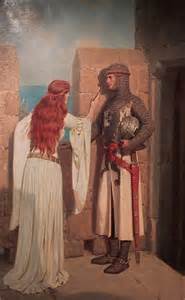 "The Shadow" by Edmund LeightonAimery de Lusignan was the third son of a Poitevan nobleman, Hugh VIII de Lusignan, a troublesome vassal of the Dukes of Aquitaine. Indeed, there was an infamous incident in 1166 when the “Lusignan brothers” — some sources expressly say Geoffrey and Guy — attacked and killed the Earl of Salisbury. Since Salisbury was unarmed, unarmored and stabbed in the back, it was a notorious act. Significantly, Aimery’s name is never linked to the murder of Salisbury.
"The Shadow" by Edmund LeightonAimery de Lusignan was the third son of a Poitevan nobleman, Hugh VIII de Lusignan, a troublesome vassal of the Dukes of Aquitaine. Indeed, there was an infamous incident in 1166 when the “Lusignan brothers” — some sources expressly say Geoffrey and Guy — attacked and killed the Earl of Salisbury. Since Salisbury was unarmed, unarmored and stabbed in the back, it was a notorious act. Significantly, Aimery’s name is never linked to the murder of Salisbury. In or about 1174, Aimery left Poitou for the Holy Land. He was following in the footsteps of three generations of Lusignans, who had been crusaders before him. His own father had died in a Saracen prison. Aimery too was captured shortly after his arrival, and his father’s fate must have haunted him. Fortunately, King Amalric was prepared to pay his ransom. This is an important tidbit as it suggests that Aimery was an agreeable enough young man ― unlike his younger brother ― to win friends in high places.
This assessment is reinforced by the fact that, despite being a younger (third) son, he married the daughter of one of the richest and most powerful barons. This was not the usual case of a Western adventurer seducing a widow, because his bride, Eschiva d’Ibelin, was only a young girl, and the marriage was concluded with her father., the Baron of Ramla and Mirabel.
in 1180, his younger brother arrived in the Holy Land and promptly seduced the widowed (and recently jilted) Princess Sibylla. (Allegations that Aimery were behind this are spurious. Aimery did not return to the West at this time.) Sibylla's brother King Baldwin IV sanctioned a wedding, how willingly is a matter of debate. As a novelist, I suspect Aimery may have been a little jealous of his younger brother’s spectacular success, but he would obviously also have recognized that he had much to gain from it. His Ibelin in-laws on the other hand were outraged. His father-in-law had hoped to marry Sibylla himself, and was never reconciled to this marriage. In short, Aimery's improved status (as brother of the future king) came at the price of an unpleasant break with his wife’s kin. That probably didn’t seem too high a price at the time. As the brother of the future king-consort, Aimery was rewarded within a couple of years with the powerful and prestigious post of Constable.
This appointment may have been due to family connections, but Aimery acquitted himself well as constable, notably at the Battle of Le Forbelet. Likewise, a year later when Saladin tried to seize control of the important springs of La Tubanie, Aimery — notably supported by the Ibelins — successfully beat-off the attack. So, angry or not, the Ibelins were still willing to fight with him, which again suggests Aimery knew how to get along with people better than his little brother.
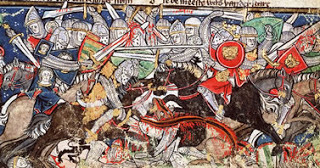
When his brother Guy made a bid for the crown in a coup d’etat three years later, however, it is unsurprising that Aimery backed his brother. This support does not necessarily imply, however, that he thought highly of his brother or his brother’s leadership. This might simply have been a matter of family loyalty and self-interest.
And he may well have regreted it. His loyalty to Guy took him to the Horns of Hattin, humiliating defeat and captivity. As the Lusignan brothers and most of the other barons of Jerusalem moldered in a Saracen prison, the entire Kingdom of Jerusalem fell city by city and castle by castle to Saladin until only the city of Tyre and isolated castles still held out. There was now no kingdom from which to raise ransoms for any of them. As 1188 dawned, Aimery de Lusignan must have expected he would suffer his father’s fate and die in Saracen captivity.
Instead, in May 1188, Saladin released the Lusignan brothers. The brothers went to Antioch, the only Crusader kingdom that was still more or less in-tact, and there recruited some 700 knights and 9,000 other ranks to attempt a re-capture Guy's lost kingdom. (This was in violation of an oath Guy had taken to Saladin, by the way.) Guy, Aimery and his little army set out for the only city of his kingdom that was still free,Tyre, only to discover that the man controlling it (Conrad de Montferrat) refused to admit them. Guy de Lusignan was persona non grata in his own kingdom ― and Aimery with him. What was more: Conrad was soon to claim the crown for himself by right of his wife, Sibylla’s younger sister Isabella. For the next three years, Guy and Conrad would be rivals, fighting over the crown of a kingdom that existed more in people's minds than in fact.
Meanwhile, the Lusignans recognized they had to do something, so they laid siege to Acre — formerly the most important port of his former kingdom and now garrisoned by Saladin’s troops. This siege was to drag on for two years and cost thousands of lives as arriving crusaders joined the siege ― and died there of disease, malnutrition, and the a constant skirmishing with the Saracen forces both inside the city and surrounding the siege camp. In November1190, disease took the lives of Queen Sibylla and her two daughters — Guy's only off-spring. With them died Guy’s sole claim to the throne of Jerusalem. Aimery remained loyally with his brother, but one wonders what he thought of him by this stage?
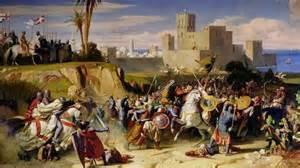 In the spring of 1191, the kings of England and France finally arrived with sufficient men and machines to bring the siege of Acre to a successful conclusion. Although Philip II soon sailed home for France, Richard the Lionheart stayed on to fight. He also staunchly backed his vassal Guy as king, but the barons and burghers of Outremer remained vehemently opposed to Guy. Richard re-established Christian control of most of the coastal cities, but then his time ran out; he had to return to his hereditary lands or risk losing them to Philip of France. Richard wanted to leave that the rump state he had helped create in hands strong and capable enough to ensure its survival; that was patently not Guy de Lusignan. Richard did the responsible thing: he dropped his support for Guy and recognized Isabella as the rightful Queen of Jerusalem and her husband (first Conrad de Montferrat and then Henry of Champagne) as King.
In the spring of 1191, the kings of England and France finally arrived with sufficient men and machines to bring the siege of Acre to a successful conclusion. Although Philip II soon sailed home for France, Richard the Lionheart stayed on to fight. He also staunchly backed his vassal Guy as king, but the barons and burghers of Outremer remained vehemently opposed to Guy. Richard re-established Christian control of most of the coastal cities, but then his time ran out; he had to return to his hereditary lands or risk losing them to Philip of France. Richard wanted to leave that the rump state he had helped create in hands strong and capable enough to ensure its survival; that was patently not Guy de Lusignan. Richard did the responsible thing: he dropped his support for Guy and recognized Isabella as the rightful Queen of Jerusalem and her husband (first Conrad de Montferrat and then Henry of Champagne) as King. That was a bitter disappointment for both Guy and Aimery, but this is where things get interesting for the Lusignans. On his way to the Holy Land, Richard I had conquered Cyprus. This immensely wealthy island which had long been part of the Byzantine Empire had been seized by a self-proclaimed “Emperor,” whose tyrannical policies had so alienated his subjects that for the most part welcomed and cooperated with Richard of England. Richard first sold Cyprus to the Knights Templar, but by April 1192 the entire island was in rebellion against their rule. The Templars, recognizing that they did not have the resources to subdue the island and fight for the Holy Land, returned the island to the King of England.
Richard sold it to Guy de Lusignan!
That was all very well for the King of England's purse, but the fact was, with the entire population now up in arms against the rule of the crusaders, Guy first had to conquer the kingdom he had bought. He set off with what few supporters he still had. Significantly, his brother Aimery did notaccompany him. This is concrete evidence that the relationship between the brothers had become strained.
Whatever their relationship in private, however, outsiders naturally still assumed they were close. The new King of Jerusalem, Henry of Champagne, was clearly suspicious of Aimery’s loyalty. When Aimery sided with the Pisans, who Henry suspected of plotting against him, he was promptly imprisoned. Aimery’s arrest, however, provoked protests from the barons of the kingdom, which supports my earlier thesis that — in contrast to Guy who seems to have been singularly adept at making enemies — Aimery was still popular among his adopted countrymen. The fact that King Henry gave in to the protests and released Aimery on the condition that he surrender the office of Constable furthermore suggests that Aimery’s supporters were very influential. I can’t help but suspect that they included Balian d’Ibelin, who was King Henry’s de jure father-in-law (he was married to Queen Isabella’s mother). Aimery duly surrendered his office of Constable of Jerusalem and promptly went to Cyprus to assist his brother Guy in taking control of his new lordship.
Yet less than two years later, Guy de Lusignan was dead ― and he designated his elder brother Geoffrey — not Aimery who had been with him so long and through so much for him— as his heir. This is the most convincing evidence that the relations between Aimery and Guy had deteriorated badly (if they had ever been good). Fortunately for Aimery, Geoffrey de Lusignan had no interest in Cyprus. So Guy’s vassals chose Aimery as his successor.
At last Aimery could demonstrate his own talents, rather than trailing in the wake of an incompetent brother. Within three years of becoming the Latin/crusader overlord of Cyprus, Aimery had established peace on the island, set up a Latin ecclesiastical hierarchy alongsidethe Orthodox one, and raised Cyprus to the status of a kingdom.
Nor was that the end of Aimery's astonishing life. In 1196/1197, Eschiva d’Ibelin died. When Henry of Champagne died in September 1197, Aimery was selected as fourth husband for Isabella of Jerusalem. Aimery promptly used his Cypriot resources to help strengthen his new kingdom. In the same year that he assumed the crown of the kingdom his brother had squandered, he recaptured the key coastal city of Beirut from Saracen control. The following year, he concluded a five year truce with the Saracens that gave the kingdom much needed breathing space to retrench and consolidate itself. It was also the year in which he named Balian d’Ibelin’s son John to his old position of Constable of Jerusalem — an exceptional mark of favor for a young man not yet 20 and one presumes more a gesture of gratitude to his father than a mark of confidence in one so young. As noted above, this is one of the reasons I think Aimery had a more cordial relationship with Balian and his family than is usually assumed.
Aimery also used the peace to commission a codification of the Laws of Jerusalem, the written records of which had been lost along with the Holy City. Drawing on the memory of the surviving members of the High Court, he attempted to capture the living memory of the unique laws of the lost kingdom and provide a constitutional basis for future legal procedures. This "Book of the King" was a significant contribution to feudal legal scholarship in the 13th century.
In 1204, with the Fourth Crusade diverted to Constantinople, Aimery concluded a new truce with the Saracens, this one with a six year duration. This gave his kingdom the peace it needed for economic recovery, but he did not live long enough to enjoy it. In April 1205, Aimery died from foodpoisoning after eating fresh fish. Isabella followed shortly afterwards. The crown of Cyprus passed to Aimery's son by Eschiva d’Ibelin, Hugh, and the crown of Jerusalem to Isabella’s oldest surviving child, her daughter Maria of Montferrat.
My novels attempt to separate Aimery from Guy and portray him throughout as an independent and very different personality to his feckless younger brother. Because his marriage to Eschiva occurred in the late 1170s, he is a character in all three books of my trilogy--and indeed beyond in my current work-in-progress about the founding of the Kingdom of Cyprus. Throughout, Aimery's relationship with Guy is fraught with jealousies, tensions and disagreements that are only barely patched-over for the sake of family unity -- just as in many families today.
Find out more by reading:

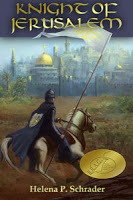

Buy now! Buy now! Buy now!
Published on March 11, 2017 22:41
March 4, 2017
Writing Biographical Fiction: Agnes de Courtenay

Agnes de Courtenay was the power behind Baldwin IV’s throne and she was a viperous enemy of my leading female character, Maria Comnena. Because of both these roles in history, I had to cede her a place in my novels. Furthermore, despite an attempt by historian Bernard Hamilton to rehabilitate her, the commentary of contemporaries and indeed the naked record of her actions condemn Agnes as a singularly stupid woman whose influence on her son was almost entirely negative. Something which, admittedly, fit in with her being the arch-enemy of Maria and so a prime candidate for a negative character in my novels. All novels need some negative characters after all….
So who was Agnes de Courtenay?
Agnes was the daughter of Joceyln II, Count of Edessa, who lost his county to the Saracens, in large part due to neglect and poor leadership. The city of Edessa was lost to Zengi in November 1144, and by 1150 the last remnants of the once rich and powerful County were in Saracen hands. Joscelyn II himself was captured in the same year by Nur al-Din and tortured. He eventually died, still in captivity, in 1159. As a result, Agnes de Courtenay did not have an easy childhood. She had been married, possibly at an early age, to Reynald of Marash, who was killed in battle in 1149. The following year, her father was captured and never seen again. In just six years, her family had fallen from one of the richest and most powerful in the crusader states, to the status “poor cousins” living on a few estates in Antioch that Agnes’ mother had from her first marriage. Agnes was a widow with no land and no dowry. She was also probably no more than 10 or 12 years old, as she would have had to be at least 8 at her marriage to Reynald.
According to historian Malcolm Barber, she was next betrothed to Hugh d’Ibelin (Balian’s oldest brother), but instead married Prince (later King) Amalric of Jerusalem. Whether she did this voluntarily is not recorded. She might have been seduced or abducted, but she might also have been very happy to give up the comparatively obscure and unimportant Hugh in favor of the heir apparent to the throne. While historians can leave unanswered the question of her feelings, a novelist cannot. Agnes’ feelings toward Hugh d’Ibelin are critical to the character Agnes in any novel about the Ibelins.
The (historical) plot thickens, however, when at the death of Baldwin III, who was childless, the High Court of Jerusalem refused to acknowledge his next of kin, Baldwin’s younger brother Amalric, as King of Jerusalem unless he set Agnes aside. Why, we do not know. There was the issue of being married within the prohibited degrees on consanguinity, and the issue of the pre-contract with Hugh d’Ibelin, both of which were canonical grounds for divorce. However, the objections of the High Court are not likely to have been legalistic in view of the fact that the High Court explicitly recognized Amalric’s children by Agnes as legitimate. This strongly suggests that the High Court was not uneasy about the legality of Amalric’s marriage but rather about the character of his wife. Regardless of their reasons, such action could only have infuriated and enraged Agnes herself. Rather than becoming Queen, she was repudiated and sent back to her former betrothed (or husband) Hugh d’Ibelin.
While historians don’t particularly need to figure out why Agnes was so despised by the High Court (the fact that she was is enough), for a novelist there is a gold mine here. It appears that Agnes was considered a ‘bad woman.’ Some historians have suggested that meant nothing more than that she was a Courtenay and expected to favor her family, but that was quite normal in the Middle Ages and hardly seems to justify such an unyieldingstance on the part of the High Court. To the novelist, the insinuations that she was a woman of “easy virtue” ― alleged to have had affairs with a bishop (the later Patriarch Heraclius) and with Aimery de Lusignan is far more intriguing―even if not proved.
Likewise, while Agnes’ feelings do not much interest historians, they are hugely important to a novelist. How would a woman, who undoubtedly felt she ought to be queen, feel about the man she is forced to (re)marry to after losing a crown? It hardly seems likely that she was fond of Hugh under the circumstances, and the fact that the marriage was childless suggests it may have been no more than nominal. Certainly she was credited with hating the woman who took her place in Amalric's bed and became -- what she could not be -- his queen: the Byzantine princess Maria Comnena. Maria was latter wife of Balian d’Ibelin.
But before that happened, Agnes had a stroke of luck. In 1176 Baldwin IV took the reins of government for himself and he invited his mother to his court. Within a few short years, Agnes had succeeded in foisting her candidates for Seneschal, Patriarch and Constable upon her young and dying son. These were respectively: 1) her utterly underwhelming brother, Jocelyn of Edessa, 2) the controversial figure Heraclius, who may not have been as bad as his rival William of Tyre claims and may not have been Agnes’ lover as the Chronicle of Ernoul claim, but hardly distinguished himself either, and finally 3) an obscure Frenchmen, also alleged to have been Agnes’ lover, Aimery de Lusignan. Not a terribly impressive record for “wise” appointments – even if Aimery de Lusignan eventually proved to be an able man.
Her next acts of influence, however, were little short of calamitous: she arranged the marriage of her son’s two sisters (and heirs), Sibylla and Isabella, to men of her choosing. We are talking here about Guy de Lusignan and Humphrey de Toron respectively.
The latter was a man of “learning,” who distinguished himself by cravenly vowing allegiance to the former after Guy seized power in a coup d’etat that completely ignored the constitutional right of the High Court of Jerusalem to select the monarch. Toron then promptly got himself captured at Hattin. Although he lived a comparatively long life and held an important barony, he apparently never played a positive role in the history of the kingdom. Not exactly a brilliant match or a wise choice for the future Queen of Jerusalem.
Agnes’ other choice, the man she chose for her own daughter according to historian Bernard Hamilton, was even more disastrous. At best, Guy de Lusignan was freshly come from France, young, inexperienced and utterly ignorant about the situation in the crusader kingdoms. At worst he was not only ignorant but arrogant and a murderer as well. He certainly alienated his brother-in-law King Baldwin IV within a short space of time, and he never enjoyed the confidence of the barons of Jerusalem. The dying King Baldwin IV preferred to drag his decaying body around in a litter -- and his barons preferred to follow a leper –- than trust Guy de Lusignan with command of the army after 1183.
Nor was this mistrust of the baronage in Lusignan misplaced. When Sibylla crowned her husband king and all the barons but Tripoli grudgingly accepted him, he led them to the avoidable disaster at Hattin. In short, Agnes de Courtney’s interference in the affairs of the Kingdom of Jerusalem, led directly to the loss of the entire Kingdom. But by then she was already dead.
As a novelist, I had no particular need to alter any of these facts or to engage in any form of revisionism with respect to Agnes. On the other hand, writing about history through the eyes of the Ibelins presented me with a problem usually overlooked by historians and novelists focused on the history of the kingdom. Namely: Agnes was Balian d’Ibelin's sister-in-law. She must have known both he and his brother very well, and their hostility to her (and vice versa) may have had more personal than political reasons.
Historians tend to simply dismiss Ibelin hostility to Agnes as “ambition” from a “notoriously” ambitious family. But Balian and his brother belong only to the second generation of Ibelins, and they didn’t yet have a track record of being particularly ambitious or successful for that matter. Indeed, the Ibelins were hardly any different from any of the baronial families at this point.
Alternatively, historians and novelists point to Agnes’ “natural” hatred of Maria Comnena, who had replaced her in her first husband’s bed and been crowned queen in her place. Certainly, this may have been the root cause of the hostility between Agnes and Maria, and through Maria to Balian and Baldwin d’Ibelin. But the tension might also have been older and deeper. It might have gone back to Agnes’ abandonment of Hugh d’Ibelin when he was in Saracen captivity just so she could marry the Prince of Jerusalem. This is the thesis I chose to expound upon in my novels as it is both logical and adds dimensions to the characters and their relationships.



Buy now! Buy now! Buy now!
Published on March 04, 2017 23:00
February 24, 2017
Writing Biographical Fiction: King Baldwin IV
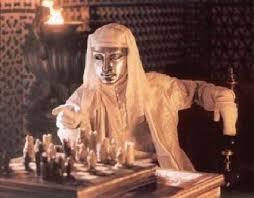 No biography of Balian d’Ibelin can ignore the man who was king for the eleven critical years 1174 – 1185, Baldwin IV. Baldwin has gone down in history as the “Leper King” simply because he suffered from this illness throughout his reign, although this moniker detracts from his significant accomplishments as king. Our image of him today is further distorted by Ridley Scott’s film “The Kingdom of Heaven” in which Baldwin IV is a leading character. So as with Balian himself, I found myself confronted with a popular image of a major character that did not necessarily conform to historical reality ― or suit my purposes as a novelist.
No biography of Balian d’Ibelin can ignore the man who was king for the eleven critical years 1174 – 1185, Baldwin IV. Baldwin has gone down in history as the “Leper King” simply because he suffered from this illness throughout his reign, although this moniker detracts from his significant accomplishments as king. Our image of him today is further distorted by Ridley Scott’s film “The Kingdom of Heaven” in which Baldwin IV is a leading character. So as with Balian himself, I found myself confronted with a popular image of a major character that did not necessarily conform to historical reality ― or suit my purposes as a novelist.Baldwin IV’s modern biographer, Bernard Hamilton, for example, provides considerable evidence that challenges conventional depictions of Baldwin IV as either peace-loving (ala Ridley Scott) or helpless (ala Jeffrey Lee). Hamilton also makes the critical point that Baldwin IV’s leprosy was not initially debilitating. Baldwin, he points out, retained the use of his left hand/arm and both legs and did not suffer from noticeable disfigurement at the time he ascended the throne. At that time, he had no visible ulcers and was able to move normally. Indeed, the contemporary chronicler and Baldwin’s tutor, the later Archbishop of Tyre, claims that Baldwin was “a good-looking child … and more skilled than men who were older than himself in controlling horses and riding them at a gallop.”
In the summer of 1176, Baldwin turned 15 and so attained his majority. He took the reins of government for himself. Unfortunately, this occurred at a time when the enemies of the Kingdom of Jerusalem were getting stronger. The Kurdish general Salah-ad-Din had seized control in both Cairo and Damascus. Baldwin IV sought to counter the rise of Salah-ad-Din by following his father's policy of alliance with the Byzantine Empire and attacking Cairo. Unfortunately, internal differences between Frankish leaders delayed the campaign, the Byzantine fleet withdrew and the bulk of the crusader and local barons and knights of Jerusalem undertook a campaign in the north. Salah-ad-Din, who had assembled his forces to meet the expected invasion, recognized that the Kingdom of Jerusalem was practically defenseless, and invaded. As he approached Ascalon, a city that had been in Egyptian hands until 1153, he prepared to besiege the city.
In a dramatic move Baldwin IV rode to the rescue of Ascalon with just 367 knights, reaching the city shortly before the Sultan's army enveloped it. But now the King of Jerusalem was in Ascalon and Jerusalem was practically defenseless. Salah-ad-Din decided to strike for heart of the kingdom: Jerusalem. Furthermore, he had such overwhelming superiority of force and so little respect for a youth of 16 that he allowed his troops to continue plundering along the way rather than concentrating on his goal. (This is such a dramatic historical event that I simply had to include it in my novel, and the best way to do was to have Balian in Ascalon at the time.)
Furthermore, Saladin had miscalculated. King Baldwin sallied out of Ascalon, called up the feudal levies and fell on Salah-ad-Din from the rear, winning a stunning and complete victory at Montgisard on November 25, 1177. While Jeffrey Lee in his recent biography of Reynald de Châtillon tries to give all the credit for this victory to subject, his case is based on the false assumption that Baldwin IV was already an invalid in a litter. In fact, there is every indication that at Montgisard Baldwin IV led his own troops on horseback, still fit enough to ride and fight.
But the consequences of this victory for Baldwin personally were devastating. Based on the historical descriptions of Baldwin’s initial illness, modern medical experts believe that Baldwin IV suffered initially from polyneuritic tuberculoid leprosy, which is comparatively mild and not necessarily debilitating. However, according to Piers D. Mitchell ("An Evaluation of the Leprosy of King Baldwin IV of Jerusalem in the Context of the Medieval World," in Bernard Hamilton's The Leper King and His Heirs, Cambridge University Press, 2000), Baldwin’s leprosy deteriorated into lepromatous leprosy during puberty. While puberty itself can induce such deterioration, so can untended wounds (that go unnoticed due to loss of feeling) which cause ulcers to break out.
When Baldwin led his daring campaign against Salah-ad-Din that led to the surprise victory at Montgisard he was in puberty, just 16 years old. It is probable that it was in part because of this campaign — which required camping out in the field and going without the usual bathing of his feet and hands — that Baldwin's leprosy took a turn for the worse.
When in 1179, Salah-ad-Din invaded a second time, Baldwin was unhorsed in the engagement, a clear indication of his deteriorating condition, and when Salah-ad-Din invaded a third time in 1182, Baldwin could no longer ride at all and had to command his army from a litter -- but still fought the Saracens to a stand-still, forcing them to withdraw. The following year, however, he was seized with fever and believing he was on his death-bed made his brother-in-law Guy de Lusignan regent. Thus when Salah-ad-Din invaded a fourth time in 1183, it was Guy de Lusignan who led the Christian armies to face him.
The results were not good. While the Saracens eventually withdrew, they had managed to do considerable damage and the barons of Jerusalem flat-out refused to follow Guy de Lusignan anywhere again. Baldwin dismissed him as regent, and dragged his disintegrating body halfway across the kingdom at the head of his army to relieve a siege of the castle of Kerak. The mere approach of the Leper King, was enough to convince Salah-ad-Din to withdraw, but by now Baldwin IV knew he did not have much time left to him. He had his nephew, Sibylla's son by her first husband William de Montferrat crowned as a co-monarch, and asked his bishops to find a way to dissolve Sibylla's marriage to Guy in the hope that another husband, more congenial to his barons, could be found for her. In the latter he failed, and hence when he died just short of his 24th birthday in the spring of 1185, he was succeeded by his nephew Baldwin V, and -- at the latter's death a year later -- by Guy de Lusignan.
Baldwin IV ruled for less than ten years and throughout his reign he was handicapped by a progressively debilitating and disfiguring disease. Yet he retained the loyalty of his subjects to the very end and on no less than five occasions prevented Salah-ad-Din's vastly superior forces from over-running his fragile kingdom. For that he should be revered and respected rather than dismissed as “the leper king.”
As a novelist, the character Baldwin IV presents several challenges ― and opportunities. First and foremost, I was determined to depict the progress of his disease realistically rather than showing him as a worthless blob in a liter from the start, as so many other modern writers. In short, my Baldwin is a youth who is ill but not debilitated when he comes to the throne, but who over the succeeding decade must come to terms with his declining strength, mobility and life-expectancy.
Other issues I had to address were Baldwin’s relationship to his mother and step-mother. Because he was separated from his mother at a very young age he could hardly have formed very close ties to her as a child. Instead, he was raised at court, primarily by nurses and tutors. Although it is usually assumed they would have had nothing to do with his step-mother Maria Comnena, it is just as possible that she took an interest in him. Indeed, in the inevitably small circle surrounding a ruling king and his heir, she might have been more like an older sister than a step-mother since she was only about seven years older than Baldwin. After becoming king, however, Baldwin welcomed his mother at his court and she rapidly gained inordinate influence over him. This suggests that although Baldwin had not known his mother well, he felt a gap or a need that Maria Comnena (either because of her age or temperament) had not be able to fill.
His relationship to his sisters appear to have been very different. First, Sibylla was only a year older than Baldwin, and although raised in a convent, she would have been present at major holidays and feasts as long as their father was alive. Given Baldwin’s later behavior to Sibylla (allowing her to marry a man totally unsuitable for example), it seems likely that they were close as children. Isabella, on the other hand, was only two years old at her father’s death and thereafter left court so that Baldwin is unlikely to have had strong bonds with her. This is borne out by the cold-hearted manner in which he ordered her taken from her mother at the age of eight and turned over to the “tender” care of a notoriously brutal man, Reynald de Châtillon.
As a novelist, these various actions suggest a youth who loved his mother and sister, but gradually came to see that they were only interested in their personal gain and so acting against the interests of his kingdom. In my novels, Baldwin suffers not only from the increasing ravages of leprosy, but also from a slow disillusionment with his mother and sister.
And then there is the issue of his relationship to Balian himself. Two historical facts suggest a close relationship. First, Baldwin explicitly consented to Balian’s scandalously advantageous marriage to the dowager queen (Baldwin’s step-mother Maria Comnena), and eight years later, when practically on his death-bed, King Baldwin selected Balian to carry his nephew in a crown-wearing ceremony; it would have been more appropriate for his nephew’s guardian (Edessa) or regent (Tripoli) to carry the young king, so this was very clearly a mark of favor quite exceptional for such an insignificant baron. Based on these admittedly thin shreds of evidence but driven by the compelling duty of a novelist to produce a good story, I created a close and early friendship between Balian and the future king, based on Balian taking over the role of riding-master. (In addition to knowing that Baldwin rode exceptionally well, there are some indications he was taught to ride by the brother of one of his Syrian Christian doctors.)
Based on the fact that after coming of age, Baldwin turned to his mother and she not only hated Balian’s wife Maria but also arranged for Maria’s daughter by King Amalric to been taken away from her, I postulated a break between Balian and King Baldwin― which is healed only shortly before the king’s death.
Baldwin IV is an important character in the first two books of my Jerusalem Trilogy.



Buy now! Buy now! Buy now !
Published on February 24, 2017 22:58
February 18, 2017
Writing Biographical Fiction: Baldwin d’Ibelin
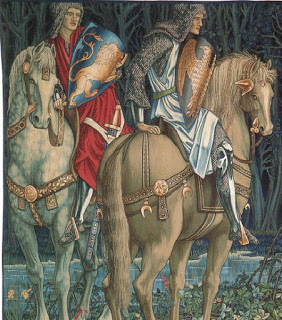 The Quest for the Holy Grail, Tapestry by Edward Burne-Jones
The Quest for the Holy Grail, Tapestry by Edward Burne-Jones When setting out to write a biography of Balian d’Ibelin, one of the first things I learned was that he was the third son of the first Baron of Ibelin, and as such started out in life as an insignificant and obscure landless knight. It was, historically, his elder brother Baldwin, who was important ― at least throughout Balian’s youth and early manhood. Furthermore, it was his brother who gave Balian his chance to enter history.
Big Brother Baldwin inherited their father’s modest barony of Ibelin in or about 1170 along with their mother’s significantly more substantial inheritance, the baronies of Ramla and Mirabel. Together, these three baronies owed 70 knights to the feudal army, or more than, for example, the powerful Lord of Oultrejourdain, which owed 60. Furthermore, unlike Oultrejourdain, all three of these baronies were located on the fertile coastal plain east and south of Jaffa, and must have yielded very substantial revenues and enabled a splendid lifestyle for the period. Although technically Baldwin was a “rear vassal” who held his fiefs from the Counts of Jaffa and Ascalon rather than directly from the king, the Count of Jaffa and Ascalon became King Amalric I in 1162, making Baldwin de facto a crown vassal. Thus when Balian came into manhood he stood very much in the shadow of his elder brother Baldwin. In writing my biographical novel of Balian, therefore, Baldwin had to be an important character.
But what was Balian’s relationship to his elder brother like?
We know that later chronicles and modern historians, writing after Balian had become the founder of a powerful dynasty that played a key role in the history of crusader states for three hundred years, often lump Baldwin and Balian together. Indeed, there is a tendency to refer to Baldwin and Balian as “the Ibelin brothers,” although this term is anachronistic since Ramla and Mirabel were more important baronies and Baldwin in his own lifetime would have been identified and addressed by these more senior titles. Ibelin, on the other hand, was not only a comparatively insignificant title, but one that Baldwin surrendered (whether willingly or not is an open question) to his younger brother in or about November 1177. He would not have been identified by or with it after that date. This careless lumping of Baldwin and Balian together by the name that was to become important only after both of them were dead, ie. as “Ibelins,” tends to create an impression of closeness and harmony that may be entirely fictional.
To be sure, in the 12th century family ties were imprisoning. Everything revolved around family. Families stuck together through thick and thin. They paid each other's ransoms, they stood as hostages for one another, they were witnesses for one another, they were each other’s clients and lords. Perhaps most important: they fought together.
Does that mean that all family members got along with one another all the time? Highly unlikely. On the contrary, the tensions within medieval families could be brutal and bitter. (Witness the Plantagenets: Henry II had to fight wars with his sons, and his sons fought each other in a series of shifting alliances.) In most families (where there was less at stake or personalities (and egos) less excessive), families usually worked together and presented a common front to the outside world, yet that still did not mean they had no rivalries and tensions among themselves.
As a novelist, therefore, I had to look beyond the undifferentiated treatment of Balian and Baldwin as two peas in a pod or two interchangeable parts of a pair and look at them as individuals. Furthermore, I had to draw on my understanding of human nature in creating a plausible relationship. Sibling rivalry is one of the most consistent and frequent patterns of behavior across cultures and ages. It is therefore quite plausible that Baldwin and Balian were not always the best friends, much less always of one opinion.
For example, William of Tyre claims that Baldwin of Ramla (Ibelin) plotted with Tripoli and Antioch to depose Baldwin IV, and all sources agree that Baldwin refused to take the oath of fealty to Guy de Lusignan. Indeed, in a shocking and unprecedented incident, Baldwin renounced his entire inheritance and went into voluntary exile, rather than take an oath of fealty to Guy de Lusignan. That is the action of a man of great pride, passion and inflexible principles.
Balian, on the other hand is most famous for his role as a mediator ― between Tripoli and Lusignan, between Richard the Lionheart and Saladin. He is also known as a man of compassion and humility, who did not lay claim to particular influence, much less a crown, even when he was step-father to the queen or when the Arab chronicles describe him as “like a king.” Unlike his elder brother, Balian’s loyalty to Baldwin IV and V is never questioned, and indeed he served Guy de Lusignan as long as Queen Sibylla lived.
In their personal lives also, the brothers appear to have been very different. Baldwin married very young, and then set his wife of almost two decades and the mother of his daughters aside―apparently for no better reason than he hoped to marry the Princess Sibylla. When that failed (for whatever reason), Baldwin married again twice. He had one son, but he abandoned the boy to Balian’s care when he renounced his titles. In short, his pride and principles with respect to Guy de Lusignan were more important to Baldwin than his wife and son.
Balian, in contrast, is depicted even by his detractors as a man very attached to his wife. Strikingly, Balian was not too proud to beg a favor of his worst enemy, the Sultan of Damascus, for the sake of rescuing his wife and children. Certainly, the idea of riding hundreds of miles through enemy held territory to remove his wife and children from Jerusalem is almost crazy, and suggests ties of affection unusual in this age. Tripoli, although described as an affectionate husband, had only a few days earlier urged the army not to relieve the siege of Tiberius, although his wife was caught in the fortress and requested relief.
In short, I think it is safe to suggest that historically Baldwin and Balian, no matter how closely they cooperated with one another, were men of very different temperaments and character. As a novelist, furthermore, emphasizing those differences and creating a degree of tension between them was an excellent plot device. In addition, the contrast to Baldwin enabled me to highlight important aspects of Balian’s character. The Baldwin of my novel is therefore not only proud and unbending, he is impulsive, hot tempered, flamboyant and arrogant as well – as I believe many older sons in this age of merciless primogeniture often were.



Buy now! Buy now! Buy now!
Published on February 18, 2017 23:00
February 11, 2017
Writing Biographical Fiction: Maria Comnena
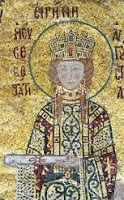
Maria Comnena, the wife of my central character Balian d’Ibelin, has an almost universally bad press. The Itinerarium characterizes her as “godless” and “fraudulent” and one of the most respected modern historians, Bernard Hamilton, describes her as “ruthless and scheming.” In literature, she is invariably cast as ― at best ― an unpleasant intriguer (e.g. Sharon Kay Penman in “Lionheart”) and ― at worst ― an evil witch (e.g. Hana Norton in “The Serpent’s Crown”) Yet, her marriage of Balian was almost certainly a love match on her part (if nothing else because no one, not even the king, could have forced a Byzantine princess and dowager queen of Jerusalem to marry against her will, nor was it the custom of the kingdom to do so). Furthermore, Balian’s devotion to her was demonstrated dramatically by his efforts to rescue her from Jerusalem even if it meant begging a favor of his worst enemy. Why would Balian have been so devoted to a bitch (not to say witch)?
So my dilemma as a novelist was to try to first identify and understand why Maria was described in such negative terms by contemporaries and then decide if the characteristics that offended 13thcentury clerics were truly offensive. And secondly, as with Balian, I had to go beyond what was written about her and try to find evidence of what she didthat would give me insight into the kind of woman she really was.
After doing my research, it became clear that Maria’s negative image in contemporary and modern sources can be traced back to a single incident: she pressured her daughter Isabella into assenting to the annulment of her first marriage in order to enable a second marriage to Conrad de Montferrat. Because this second marriage was against the interests of the English king, his supporters heap insults on Maria (and incidentally Balian as well). Because Isabella’s divorce from her first husband also paved the way for her marriage to Henry of Champagne, and her daughters by Champagne laid claim to their father’s county several decades later. French chronicles (beholden to the local claimants to Champagne) were frantic in their efforts to defend their patrons ― even if it meant slandering a dead woman on the other side of the world. In short, the primary sources that heap abuse on Maria Comnena are biased against her and anything but credible. Furthermore, aside from this oneinstance of pressuring her daughter to do what was good for the kingdom, neither medieval nor modern historians bring forth a single other example of her “scheming,” “deviousness” or “treachery.”
As for saying she was “steeped in Greek filth from the cradle,” this may have resonated well with Latin clerics after the sack of Constantinople by Western mercenaries (aka the 4thCrusade), but it should not be used by modern historians (or novelists) as evidence of anything derogatory about Maria Comnena. On the contrary, what this actually tells us is that Maria Comnena was educated and raised at the most civilized city in the contemporary world: the imperial court in Constantinople. It means, objectively, that she enjoyed the high levels of education traditionally accorded the daughters of the Imperial family. She would have learned to read and write in Greek, Latin and French. Her great uncle was one of the most important patrons of the arts, responsible for a veritable artistic revival throughout the Eastern Roman Empire, and Maria personally is credited with inviting Byzantine artists to the Kingdom of Jerusalem to carry out a renovation of the Church of the Nativity at Bethlehem ― work whose quality we admire to this day.
Looking beyond the facile descriptions of Maria Comnena written by sources with an interest in discrediting her to her actions, I began to obtain a very different picture. As I note above, she was highly educated, and raised amidst not only splendor and elegance but at the vortex of power politics surrounding the most powerful monarch on earth at the time. Had she been destined for a nunnery, she might have remained apolitical or naïve, but instead she was selected for the diplomatically vital role of marriage to a foreign king at the age of about 13. (We don’t know the date of her birth, so her age is not certain, but her aunt Theodora was sent to the court of Jerusalem to marry Baldwin III when she was this age, so it is reasonable to assume Maria was roughly the same age when she was sent to Jerusalem.)
Once she was Queen of Jerusalem she distinguished herself as a patron of the arts, but she also accompanied her husband on his trip to Constantinople. Conceivably, she was even behind this trip and may have at least been a factor inducing him to seek closer ties to the Eastern Roman Empire. If so, it was a very wise policy that offered the crusader kingdom the best form of defense against resurgent Islamic aggression. Her political astuteness ― or at least her presumed understanding of politics in Constantinople ― is confirmed by the fact that the Count of Flanders sought her political advice in 1177 when a joint military campaign with Constantinople was undertaken.
Maria Comnena’s second marriage is nothing less than a refutation of all allegations of being “power hungry.” A woman concerned with power and influence does not marry the landless younger son of a minor baron. Balian was so far beneath Maria in rank that the marriage would have been an insult and humiliation, and no one ― certainly not her teenage step-son, nor his unpopular mother ― could have forced Maria Comnena into it against her will. The precedent had been set in the Kingdom of Jerusalem (at the latest by Constance of Antioch, who defied a far more powerful monarch than the Leper King), that widows, even reigning widows whose choice of husband was far more political than for dowagers, married men of their own choosing. Maria Comnena, however, was doubly secure against any attempts to marry her against her wishes because she had the protection of Constantinople. Had a mere King of Jerusalem attempted to humiliate a daughter of the Imperial family with an unworthy marriage, the Emperor of the Eastern Roman Empire would have been compelled to defend his honor. The increasingly debilitated Baldwin IV would not afford and had no desire to provoke the wrath of Constantinople. Maria Comnena married Balian d’Ibelin because she wanted to. Period.
As Balian’s wife, she stepped down from center stage and (unlike the “ruthless” and “scheming” woman of legend), engaged in no recorded act of political interference. Indeed, she does not appear in the historical record again until Saladin sends his bodyguard to Jerusalem to remove her from danger before he began his assault. We do, however, hear of her dower barony of Nablus being attacked by a Saracen army in 1184. Since the army of Jerusalem was at this time gathered to relieve the Castle of Kerak, Balian could not have commanded the defense. All Christians in the city found refuge in the citadel and there were no casualties, something found worthy of positive commentary. The name the commander is not recorded, but the defense was most likely commanded by Maria Comnena herself. It was her city and women in the Holy Land of this period usually commanded the garrisons in their husband’s absence.
Maria’s next appearance in history is when she tells her daughter Isabella that unless she divorces Humphrey of Toron she can have “neither honor nor her father’s inheritance” ― i.e. the crown of Jerusalem. Here Maria is acting very much as a daughter of her house but also in the interests of her adopted country to secure the crown for a military competent king who enjoys the backing of the High Court of Jerusalem.
After this one act, although Maria’s daughter was Queen of Jerusalem from 1192 to 1205, there is not a single instance of her “interfering” in the affairs of the Kingdom. Again this is very odd behavior for an allegedly unscrupulous, devious and power-hungry woman.
In short, not a single fact supports the allegations against her.
Once I’d established the facts to my satisfaction, my objective as a novelist was to erase the slander obscuring our understanding of the historical Maria Comnena and to portray her as a woman who did her duty to her own family with her first marriage and followed her heart with her second. My Maria is thus highly educated, sophisticated and politically astute (as a daughter of the Byzantine court), but not in the least power-hungry, scheming or faithless. This is a woman who marries for love at 23 and thereafter devotes herself to the welfare of her family. This includes ensuring that her eldest child inherits the crown to which she is entitled (by extricating herself from an illegal and disadvantageous marriage), but does not entail trying to exercise undue influence over her daughter once she is queen. The Maria Comnena of my novels is competent, practical and financially savvy, but she has no need to be greedy, grasping or vindictive because she is supremely secure in herself and her love.



Buy now! Buy now! Buy now!
Published on February 11, 2017 23:00
February 4, 2017
Writing Biographical Fiction: Balian d’Ibelin

Having discussed the problems of writing biographical fiction generally, I now want to bore down to examine the problems encountered in depicting the key historical figures of my Jerusalem trilogy, starting with Balian d’Ibelin himself.
The obvious fact is that Balian d’Ibelin did not leave any diaries, letters or documents in which he recorded his view of himself, his contemporaries or his world. All we have are references to him, accounts in which he plays a role, even descriptions of him by others, few of which knew him personally, and many of whom were hostile to him for political reasons.
In trying to re-create Balian d’Ibelin I had to start with this eclectic collection of references and then try to piece together a comprehensible picture. This is where the novelist’s duty to create a coherent and compelling story takes precedence over a historian’s duty to address every single fact or shred of evidence. While a historian needs to examine all the evidence ― even if it only to explain why it is irrelevant, forged, falsified or anachronistic, a novelist needs to pare away superfluous and contradictory facts in order to create a character that is convincing at a human level. That doesn’t mean a character can’t have contradictions and complexity, but they must be plausible and understandable so that readers find the character credible and have the desired reaction.
Furthermore, because my novels are not merely reflections of reality but also intended to stimulate thought and reflection on a variety of issues of more universal relevance, I consciously fill in the blanks of the historical record with material that suits my ends as a novelist. In other words, as a biographer I strive to accurately reconstruct the object of my study, but as novelist I strive to deliver by own message throughthe character.
When creating the character Balian d’Ibelin, I started from a recorded historical fact: that he successfully bargained with Saladin for the surrender of Jerusalem on the basis of an agreement that ransomed the poor and destitute. Furthermore, when the sum of money raised from public and private sources proved insufficient to ransom all the poor in the city, he offered himself as a hostage until the balance could be raised. This was an act of man who took his responsibilities as a commander and a Christian seriously; it was also an act of exceptional compassion. It is hard to imagine any other crusading nobleman doing anything similar ― except St. Louis himself. And, significantly, it was recorded in Muslim sources, not by sources biased in Balian’s favor. It was this single fact that made Balian thematicallyworthy of a biographical novel―particularly when combined with a host of other fascinating facts such as marrying a dowager queen when just a landless knight, seeking to bridge the differences between Tripoli and Lusignan, escaping the debacle at Hattin and negotiating Richard the Lionheart’s peace with Saladin.
Having decided that Balian’s essence was his ability to identify with the poor and his willingness to make sacrifices for others, my Balian novels had to incorporate all known facts in such a way that when combined they show how Balian developed and evolved into the type of man who would fulfill this destiny. Where I lacked historical material, I interpolated and invented events and episodes, but always with one end in mind: preparing the reader for Balian’s historical role by describing characteristics and feelings consistent with a person who would behave as the historical Balian did.
It also meant that I had to discount or dismiss some historical references to Balian which did not fit into the overall picture (and my interpretation of it). For example, French chronicles written more than thirty years after the fall of Jerusalem during a bitter court battle over the succession to the County of Champagne use disparaging language when referring to Balian and his wife. Yet while the language is intemperate and hostile, these sources site not a single fact or act to justify their negative opinion ― beyond the (undeniable but fully justifiable) fact that Balian supported the divorce of his step-daughter from Humphrey de Toron (as did the Duke of Burgundy, the High Court of Jerusalem, the Papal Legate and many others).
Likewise, the insults heaped on Balian d’Ibelin in the English Itinerarium are empty insults without a shred of evidence to support them. The Itinerarium calls Ibelin “treacherous” only because he acted as Conrad de Montferrat’s envoy to Saladin in November 1191. Yet less than a year later Richard the Lionheart used him as an envoy to Saladin too. Clearly, King Richard didn’t think Ibelin was “treacherous.” The Itinerariumalso calls him “cruel,” again without siting a single example. Without any example, however, the accusation is not credible and unworthy of inclusion.
Another problem I had to deal with is the tendency of modern historians to refer to “the Ibelins” as ambitious and grasping based on the astonishing success of Balian’s descendants. It is true that the Ibelins became the most powerful non-royal family in Latin East from the 13th to 15thcentury, but Balian was a landless knight and his elder, more powerful brother just one of a score of barons. In Balian’s own lifetime there is no reason to impute particularly sinister motives to every action, or to justify the vicious hostility of the Courtenay’s with insinuations of probable disloyalty based simply on the fact that the Ibelins were later so powerful.
Furthermore, while it is plausible that Ernoul, as a former squire of Balian, was biased in favor of his former employer/patron, that does not mean that we have to turn everything Ernoul says into its opposite in order to get the true picture. Certainly, not everyone would have had a positive view of Balian d’Ibelin, but the fact that his squire was loyal even decades later suggests that he might indeed have been an exceptionally good lord, a man who earnedloyalty.
Without doubt, by focusing on the negative commentary available in hostile sources and discounting the commentary of Ernoul and the Arab chronicles, it would be possible to build and even justify a character in a novel that is very different from my own. That is the nature of historical fiction. But my Balian d’Ibelin is completely compatible with the historical record and, as my readers have attested, also an attractive, engaging and inspiring character.



Buy now! Buy now! Buy now!
Published on February 04, 2017 23:00
January 29, 2017
Writing Biographical Fiction: Balian d’Ibelin

Having discussed the problems of writing biographical fiction generally, I now want to bore down to examine the problems encountered in depicting the key historical figures of my Jerusalem trilogy, starting with Balian d’Ibelin himself.
The obvious fact is that Balian d’Ibelin did not leave any diaries, letters or documents in which he recorded his view of himself, his contemporaries or his world. All we have are references to him, accounts in which he plays a role, even descriptions of him by others, few of which knew him personally, and many of whom were hostile to him for political reasons.
In trying to re-create Balian d’Ibelin I had to start with this eclectic collection of references and then try to piece together a comprehensible picture. This is where the novelist’s duty to create a coherent and compelling story takes precedence over a historian’s duty to address every single fact or shred of evidence. While a historian needs to examine all the evidence ― even if it only to explain why it is irrelevant, forged, falsified or anachronistic, a novelist needs to pare away superfluous and contradictory facts in order to create a character that is convincing at a human level. That doesn’t mean a character can’t have contradictions and complexity, but they must be plausible and understandable so that readers find the character credible and have the desired reaction.
Furthermore, because my novels are not merely reflections of reality but also intended to stimulate thought and reflection on a variety of issues of more universal relevance, I consciously fill in the blanks of the historical record with material that suits my ends as a novelist. In other words, as a biographer I strive to accurately reconstruct the object of my study, but as novelist I strive to deliver by own message throughthe character.
When creating the character Balian d’Ibelin, I started from a recorded historical fact: that he successfully bargained with Saladin for the surrender of Jerusalem on the basis of an agreement that ransomed the poor and destitute. Furthermore, when the sum of money raised from public and private sources proved insufficient to ransom all the poor in the city, he offered himself as a hostage until the balance could be raised. This was an act of man who took his responsibilities as a commander and a Christian seriously; it was also an act of exceptional compassion. It is hard to imagine any other crusading nobleman doing anything similar ― except St. Louis himself. And, significantly, it was recorded in Muslim sources, not by sources biased in Balian’s favor. It was this single fact that made Balian thematicallyworthy of a biographical novel―particularly when combined with a host of other fascinating facts such as marrying a dowager queen when just a landless knight, seeking to bridge the differences between Tripoli and Lusignan, escaping the debacle at Hattin and negotiating Richard’s peace with Saladin.
Having decided that Balian’s essence was his ability to identify with the poor and his willingness to make sacrifices for others, my Balian novels had to incorporate all known facts in such a way that when combined they show how Balian developed and evolved into the type of man who would fulfill this destiny. Where I lacked historical material, I interpolated and invented events and episodes, but always with one end in mind: preparing the reader for Balian’s historical role by describing characteristics and feelings consistent with a person who would behave as the historical Balian did.
It also meant that I had to discount or dismiss some historical references to Balian which did not fit into the overall picture (and my interpretation of it). For example, French chronicles written more than thirty years after the fall of Jerusalem during a bitter court battle over the succession to the County of Champagne use disparaging language when referring to Balian and his wife. Yet while the language is intemperate and hostile, these sources site not a single fact or act to justify their negative opinion ― beyond the (undeniable but fully justifiable) fact that Balian supported the divorce of his step-daughter from Humphrey de Toron (as did the Duke of Burgundy, the High Court of Jerusalem, the Papal Legate and many others).
Likewise, the insults heaped on Balian d’Ibelin in the English Itinerarium are empty insults without a shred of evidence to support them. The Itinerarium calls Ibelin “treacherous” only because he acted as Conrad de Montferrat’s envoy to Saladin in November 1191. Yet less than a year later Richard the Lionheart used him as an envoy to Saladin too. Clearly, King Richard didn’t think Ibelin was “treacherous.” The Itinerariumalso calls him “cruel,” again without siting a single example. Without any example, however, the accusation is not credible and unworthy of inclusion.
Another problem I had to deal with is the tendency of modern historians to refer to “the Ibelins” as ambitious and grasping based on the astonishing success of Balian’s descendants. It is true that the Ibelins became the most powerful non-royal family in Latin East from the 13th to 15thcentury, but Balian was a landless knight and his elder, more powerful brother just one of a score of barons. In Balian’s own lifetime there is no reason to impute particularly sinister motives to every action, or to justify the vicious hostility of the Courtenay’s with insinuations of probable disloyalty based simply on the fact that the Ibelins were later so powerful.
Furthermore, while it is plausible that Ernoul, as a former squire of Balian, was biased in favor of his former employer/patron, that does not mean that we have to turn everything Ernoul says into its opposite in order to get the true picture. Certainly, not everyone would have had a positive view of Balian d’Ibelin, but the fact that his squire was loyal even decades later suggests that he might indeed have been an exceptionally good lord, a man who earnedloyalty.
Without doubt, by focusing on the negative commentary available in hostile sources and discounting the commentary of Ernoul and the Arab chronicles, it would be possible to build and even justify a character in a novel that is very different from my own. That is the nature of historical fiction. But my Balian d’Ibelin is completely compatible with the historical record and, as my readers have attested, also an attractive, engaging and inspiring character.



Buy now! Buy now! Buy now!
Published on January 29, 2017 01:29
January 28, 2017
Living with Ghosts: Writing Biographical Fiction Part II
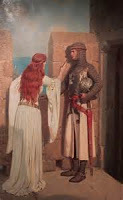 "The Shadow" by Edmund LeightonLast week I described the challenges of writing biographical fiction. This week I want to focus on the more personal complications of the genre. In normal historical fiction, as I have described elsewhere, characters often take on a life of their own, even pulling the novel in unexpected directions. My experience with headstrong characters has been overwhelmingly good. A good character has a better feel for the direction a book should go than I do. Most of my books have benefited from this fact and evolved differently from the original concept. In one case, a secondary character completely took over the book and the initially conceived story was not written at all.
"The Shadow" by Edmund LeightonLast week I described the challenges of writing biographical fiction. This week I want to focus on the more personal complications of the genre. In normal historical fiction, as I have described elsewhere, characters often take on a life of their own, even pulling the novel in unexpected directions. My experience with headstrong characters has been overwhelmingly good. A good character has a better feel for the direction a book should go than I do. Most of my books have benefited from this fact and evolved differently from the original concept. In one case, a secondary character completely took over the book and the initially conceived story was not written at all. But with biographical fiction, such course changes are unacceptable. The true biography of the central character lays down the route that must be followed. The author is free to decide which stations along the way will be described in greatest detail, maybe the author can add an embellishment here and there, but in the end the road-map must be respected. There can be no happy end where there was none in history.
Another challenge of biographical fiction is, of course, the fact that a historical figure does not “belong” to the novelist alone. A historical figure is a public figure, and that means that anyone else can choose to write about this person too. Unlike fictional characters, the novelist of a biographical novel has to “share” their central characters with others – and often compete with or assault existing interpretations. When I, for example, describe Balian d’Ibelin, my interpretation will clash in many minds with the hero of the same name created by Ridley Scott and played by Orlando Blum in the Hollywood film “The Kingdom of Heaven.” It makes no difference whether my research is better and my interpretation is more plausible. Scott’s Balian is more familiar to my reader than my historical sources and it has already occupied their consciousness. Altering readers’ perceptions of historical figures is far more difficult than creating new characters.
Finally, there is the difficultly of living with the ghosts of dead. A good biographical novelist will spend a great deal of time with the characters of his/her book and this means spending time with the dead. Depending on one’s sensibility, that can be quite unnerving. I have spent many a sleepless night, plagued by images of historical figures dissatisfied with my portrayal of them. They can be angry or simply disappointed, but they are unrelentingly hard task-masters, who demand an even higher standard of writing than their fictional colleagues.
Obviously, on the evidence of some historical novels that liberally apply the names of historical figures to characters with no resemblance to the personage carrying the same name in serious historical sources, some authors do not take their responsibilities to the dead very seriously. I wonder that they are not haunted by furious ghosts. Perhaps they are and I just don’t know about it – or the ghosts consider them so insubstantial they can’t be bothered.
Envoy of Jerusalem is the winner of the Pinnacle Award for Biographical Fiction 2016.



Buy now! Buy now! Buy now!
Published on January 28, 2017 23:00
January 21, 2017
The Art of Writing Biographical Fiction - Part I
This week I start a new series about the challenges of writing novels about real historical figures.

While I have been writing historical fiction all my life, I only started to focus on biographical fiction after earning my PhD with a biography of General Friedrich Olbricht. Combining the skills of a biographer were those of a novelist is an even greater challenge than combining the skills of an historian with those of a novelist. History provides a context for fictional characters, but leaves the novelist almost infinite freedom to fit their characters into the general historical framework. Biographical fiction requires a higher degree of discipline and forces a novelist to operate within a more rigid structure. The rewards of evolving an internally consistent and legitimate interpretation of a historical figure are, however, almost indescribable.
The fact is, for most historical figures information about what went on inside their hearts and minds is scarce. We might have the odd letter or two, or if very lucky a diary, but the farther back in history a person lived, the less likely we are to have authentic, first-hand material. Most of what we know about historical figures was recorded at best by contemporary chroniclers, and more often by observers who lived decades or even centuries later. Many historical records come from foreign sources – Athenians writing about Sparta, Christian monks recording the raids of the Vikings, or Frenchmen decrying the atrocities of the English in the Hundred Years War. Even where we have contemporary, domestic sources, these may be hostile to the subject, for example the interrogation records of the Inquisition describing the Cathars or Gestapo memos on the German resistance to Hitler.
What this means is that the best information we have about historical figures is usually their actions. My father always told me to judge a man by what he did, not what he said, but this can be very difficult across the distance of 500 years or more. And, of course, in certain situations we cannot even be sure that deeds attributed to one personality or another were in fact committed by them. Did Richard III order the murder of his nephews or didn’t he? The sons of Edward IV disappeared while Richard III was king. Bones have been found that appear to match boys their age. Carbon dating suggests a death date within the period of Richard’s short reign. Yet anyone familiar with the Richard III controversy knows there are powerful arguments against Richard’s guilt and a number of other historical figures, who could have committed (or ordered) the murders.
In short, while a novelist writing biographical fiction has to keep to the known facts, he/she still has a great deal of leeway. In most cases, there is almost unlimited freedom when it comes to describing emotions and attitudes, and these in turn determine the nature of relationships and – ultimately – the character of an individual. With the identical set of facts, two good historical novelists could create equally convincing and yet virtually opposite characters. Sticking to my Richard III example: the bald fact is that Richard married Anne Neville, the widow of his arch-rival, the Lancastrian prince Edward. Depending on how one interprets this fact, he either forced himself on a helpless, grieving widow or he rescued his childhood sweetheart after her father bartered her into a hated first marriage.
It is all about interpretation, a phenomenon that actors will recognize well. In a play, the same actions, even the same lines, can be transformed by interpretation – and that is what makes writing biographical fiction so much fun.
Envoy of Jerusalem won the Pinnacle Award for Best Biographical Fiction 2016.

 Buy now!
Buy now!
Published on January 21, 2017 23:00
January 14, 2017
Cast of Characters: Beatrice and Constance
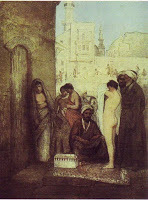
I wanted to end my series on the fictional characters in my Balian d'Ibelin series with the sisters Beatrice and Constance d'Auber, the daughters of Sir Bartholomew, because of their importance to Envoy of Jerusalem.
Although fictional, these two characters are as important to Envoy of Jerusalem as Richard the Lionheart and Saladin. They were created to give names and faces to the tens of thousands of real women who went into Saracen slavery when the Kingdom of Jerusalem was overrun by Saladin's forces. They also represent -- and are intended to remind us of -- the Yazidi women enslaved by ISIS, the Syrian refugees sold into illegal marriages in Turkey, and indeed every trafficked woman in the world today.
Beatrice and Constance are the thematic mortar of Envoy of Jerusalem. It is the fate of the captives that haunts Balian from start to finish of the novel. Without Beatrice and Constance and their children, the novel would be gutted of meaning; the reader would not be able to fully understand what Balian does and why.



Buy now! Buy now! Buy now!
Published on January 14, 2017 23:55



